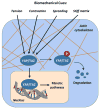Mechanotransduction and fibrosis
- PMID: 24709567
- PMCID: PMC4425300
- DOI: 10.1016/j.jbiomech.2014.03.031
Mechanotransduction and fibrosis
Abstract
Scarring and tissue fibrosis represent a significant source of morbidity in the United States. Despite considerable research focused on elucidating the mechanisms underlying cutaneous scar formation, effective clinical therapies are still in the early stages of development. A thorough understanding of the various signaling pathways involved is essential to formulate strategies to combat fibrosis and scarring. While initial efforts focused primarily on the biochemical mechanisms involved in scar formation, more recent research has revealed a central role for mechanical forces in modulating these pathways. Mechanotransduction, which refers to the mechanisms by which mechanical forces are converted to biochemical stimuli, has been closely linked to inflammation and fibrosis and is believed to play a critical role in scarring. This review provides an overview of our current understanding of the mechanisms underlying scar formation, with an emphasis on the relationship between mechanotransduction pathways and their therapeutic implications.
Keywords: Fibrosis; Mechanical signaling; Mechanotransduction; Scarring.
Copyright © 2014 Elsevier Ltd. All rights reserved.
Figures



References
-
- Aarabi S, Bhatt KA, Shi Y, Paterno J, Chang EI, Loh SA, Holmes JW, Longaker MT, Yee H, Gurtner GC. Mechanical load initiates hypertrophic scar formation through decreased cellular apoptosis. FASEB J. 2007;21(12):3250–3261. - PubMed
-
- Agha R, Ogawa R, Pietramaggiori G, Orgill DP. A review of the role of mechanical forces in cutaneous wound healing. J Surg Res. 2011;171(2):700–708. - PubMed
-
- Agrawal C, Ray RB. Biodegradable polymeric scaffolds for musculoskeletal tissue engineering. J Biomed Mater Res. 2001;55(2):141–150. - PubMed
-
- Akaishi S, Akimoto M, Hyakusoku H, Ogawa R. The tensile reduction effects of silicone gel sheeting. Plast Reconstr Surg. 2010;126(2):109e–111e. - PubMed
-
- Alenghat FJ, Ingber DE. Mechanotransduction: all signals point to cytoskeleton, matrix, and integrins. Sci STKE. 2002;2002(119):pe6. - PubMed
Publication types
MeSH terms
Grants and funding
LinkOut - more resources
Full Text Sources
Other Literature Sources
Medical

